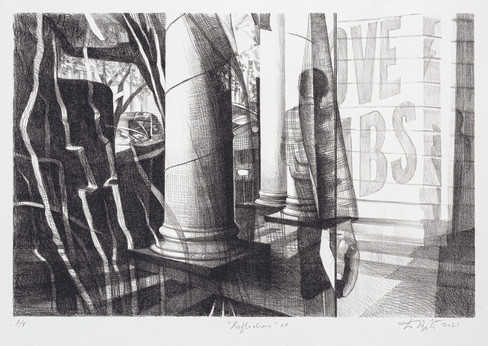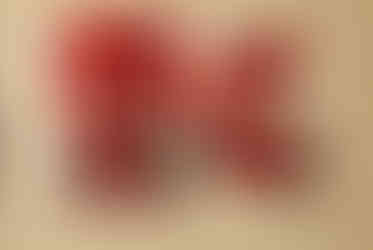Divergence and Continuity in Indian Printmaking Practice
- Ranjan Kaul

- May 21, 2023
- 7 min read
by Ranjan Kaul
The just concluded exhibition at Dhoomimal Gallery (April-May 2023) titled “Of Divergent Practices: The Trajectory of Printmaking”, curated by Ina Puri, showcased recent works of a group of five printmakers along with rare prints by earlier masters from the Dhoomimal Gallery archives. The exhibition was a splendid display of the complete spectrum of printmaking techniques, from woodcut to engraving to lithography, etching and silk-screen printing.

Raja Ravi Varma, Untitled, Oleograph, 13 x 19.5 inches
While the history of printmaking goes back to the Han Dynasty (206 BC to AD 220) with the earliest known example being of a woodblock print on silk, the use of printmaking in the fine arts is credited to German artists of the 15th and 16th centuries. In India printmaking can be traced to Raja Ravi Varma who set up a press in the early 1890s to disseminate his works to larger audiences. Successive generations of Indian artists, including Chittaprosad Bhattacharya, Somnath Hore, Haren Das, Jyoti Bhatt, Anupam Sud and K.R. Subanna, among many others, kept printmaking alive in the country, exploring the medium for their individualistic expression. Around 1990, a dozen printmakers formed a collaborative group, the Indian Printmakers Guild. Over time, some artists of the Guild chose to go separate ways; it was then that a splinter group (who had already been working together in their own individual studios at the Lalit Kala Akademi’s Garhi Studios since the time the Guild was formed) decided to continue working together, while continuing to remain connected with the others who had moved away to pursue their own paths. This printmakers’ group (which included Vijay Kumar and K.R. Subbanna) has been holding collaborative shows under the appellation ‘Multiple Encounters’ for quite some years now. One floor of the gallery was dedicated to the works of five of these modern and contemporary printmakers – Anandmoy Banerji, Dattaraya Apte, Kavita Nayar, Moti Zharotia, and Sushanta Guha, while another floor showcased the older masters.
Anandmoy Banerji in his woodcut and linocut series Human Landscape (2022), as in his earlier works, continues to wrestle with the idea of the human existential crisis and the struggle of the individual to reconcile with the changing civilizational ethos and societal challenges. Limiting himself to two plates of a refreshing flesh pink and black, in this new series Banerji uses textural devices such as scratches, flowing parallel lines and black solids to create arresting forms and tonalities. Seamless relational constructs of limbs float in space coalescing into subtle yet dramatic shifts of colour and shape, which at times assumes menacing forms or calm, oval-shaped placid expressions. The works perhaps suggest that in the ultimate analysis each individual is left with little choice but to deal with life’s predicaments and personal demons by themselves. At a macro level. this reviewer interprets the forms as a reflection of society at large, where the the viper of hate has been of late sniping at ordinary citizens; at same time the softer, flowing forms are suggestive of the fond hope that better sense will ultimately prevail. The series of The Dark Night, created during the Covid times portrays humankind's helplessness to cope with not only the suffering brought about by the pandemic but in relation to individual predicaments and social realities as well.
Clockwise from top: Anandmoy Banerji, Human Landscape – Period 2022-A, Unique Print I, 60 x 32 inches; Human Landscape – Period 2022-C, Unique Print III, 60 x 32 inches; The Dark Night 2020-21 A, Linocut - edition print, 15 x 12 inches; The Dark Night 2020 -21 B, Linocut - edition print, 15 x 12 inches
The black-and-white masterful intalglio prints of Dattatraya Apte created during the Covid lockdown reflect a mood of solitude and loneliness. Reflections CP, as the title indicates, depicts the reverberating reflections on transparent glass through the interior of a showroom in the Connaught Place (CP) marketplace. A pillar assumes centre stage – a vestige of the colonial past – juxtaposed with the back of a solitary figure leaning on another pillar seen from inside the showroom, resting his heel against the glass frontage. In Lockdown Reflection I, time seems to be almost frozen, as the figure (he artist himself presumably) sits with legs crossed below his chair, wearing a mask and gloves, as he looks about at the objects around him, such as the sanitizer and a mini oxygen cylinder related to the pandemic.
Dattaraya Apte, Left: Reflections CP, Lithograph, 16 x 23 inches, 2021; Right: Lockdown Reflection, Intaglio I, 26 x 19 inches, 2021
Kavita Nayar’s heavily etched, textured prints with multiple assembled plates and burnt paper in deep reds and browns of the shimul (silk cotton) flower are laden with heavy symbolism, drawing upon the artist’s subconscious storehouse of memories. The fragile petalled images transcend into a rich blossom of reds, slowly spreading outwards, till they finally scatter on the ground, creating a spectrum of moods. While the petal fragments lying on the ground convey a pervading sense of loss, we see a luminous flow of positive energy emanating from the certainty of regeneration.



Kavita Nayar, Memories IV-VI, Etching with burnt paper, 5 x 10 inches , 2022;
Transcending, Assembled etching prints, 30 x 30 inches, Ed: 1/1, 2022;
Liberated, Etching with multiple plates, 29 x 29 inches, Ed: 1/1, 2022


Indigestion of Civilization, Lithograph, 18.5 x 59 inches, 2022;
Time Traveller, Lithograph, 18 and 72 inches, 2020-21
Sushanta Guha has for several years now been focusing on social and humanitarian issues such as the disintegration of human sensibilities and values, atrocities against women, religious fanaticism, and so on. He mainly works with lithograph prints (he says that he has been using a large stone – about 28” x 22” – since the last two decades, which is now reduced to almost half its original depth owing to its repeated use). In his work Indigestion of Civilisation, Guha uses a collage of images to make a poignant commentary on contemporary social realities where violence and atrocities against women seem to have become the order of the day. At the bottom left we see shocked onlookers staring in disbelief at a discovered corpse with chopped limbs. In another image, against the backdrop of minarets, is a man being thrashed because he is walking a cow (possibly on the erroneous assumption that it is being taken for slaughter). The central motif is that of a lustful-looking man holding a naked woman (which could be his wife), suggestive of a patriarchal society in which women are treated as personal property. In another scene we see a defenseless woman with the gesture of her hands suggesting a mix of resistance and helpless submission, while on the extreme right a common man is left to wonder what the future is in store for him.
In Time Traveller the central image is that of an emaciated Buddha meditating in the lotus pose, impervious to worldly and sensual distractions. The artist seems to suggest that need to find the right balance in today’s strife-torn society: the figure in a space suit on the left, indicative of technological and civilizational advances, is contrasted on the far right with protesting farmers compelled to take to the streets.
Moti Zharotia’s serigraphy prints depict the intertwining relationship between humans and nature, Purusha and Prakriti. The elongated medley of the human and natural forms comingle, morphing to a decorative abstraction.
Moti Zharotia, Left: Purush & Prakriti series, Serigraph, 19.5 x 14 inches, 2017; Right: Buoyancy, Serigraph, 29 x 20 inches, 2020
Clockwise from top: K.G. Subramanyan, Untitled, Lithograph, 20 x 22 inches, Ed: 1/4, 1993];
Haren Das, Chiaroscuro, Woodcut, 7 and 9 inches, 1962; Jyoti Bhatt, Self-portrait in New York, Etching,
19 x 14 inches, 1969; Lalu Prasad Shaw, Swing Door, Etching, 20 x 20 inches, Ed: 4/10, 1974
Among the collections of the masters displayed on a separate floor that caught my fancy included K.G. Subramanyan’s untitled lithograph of sea creatures, the crab, lobster and fish floating in a sepia-tinted frame. Jyoti Bhatt's self-portrait, created during his visit to New York, is another strikingly imaginative etching where we see the abstracted figure of the artist in a black suit walking through the doorway of his pullover, as it were, on a wintry day wearing ochre-coloured gloves. Haren Das’s small woodcut, Chiarascuro, shows a simple rustic scene in which a woman is putting out clothes to dry. Lalu Prasad Shaw’s etching. Swing Door and Somnath Hore's untitled work are dramatic works with contrasting play of clearly delineated forms - black and white, red and black.
The gamut of print works that were on display bears testimony to the immense potentialities of printmaking as a medium; the exhibition not only gave viewers an opportunity to study the wide range of printmaking techniques but also showcased the transition from the modern to the contemporary in Indian printmaking. The five contemporary printmakers of the Multiple Encounters group gave ample evidence of their efforts to keep alive the genre of printmaking through their exploratory and diverse practices, techniques and themes. While Kavita Nayar innovates materiality for self-expression, Anandmoy Banerji grapples with the human existential crisis; Dattatraya Apte and Sushanta Guha portray contemporary social realities. However, Moti Zharotia has remained content with his lyrical style of decorative modernism, marrying nature with the human form.
The works displayed in the exhibition will hopefully inspire younger generations to adopt printmaking as a medium for their art, which has stood the test of time owing to the expressive power it offers. While contemporary artists are already experimenting with the medium, including taking the liberty of mixing printmaking with painting, there is ample scope to further explore the burgeoning potential of the genre with the availability of new technologies such as digital printing, computer graphic engraving, 3D printing and artificial intelligence.
(All images are courtesy of the individual artists and Dhoomimal Gallery.)

Ranjan Kaul is a visual artist, art writer and critic, curator, author and Founding Partner of artamour. His works may viewed on www.ranjankaul.com and his insta handle @ranjan_creates.


































Excellent reading material for the art world.